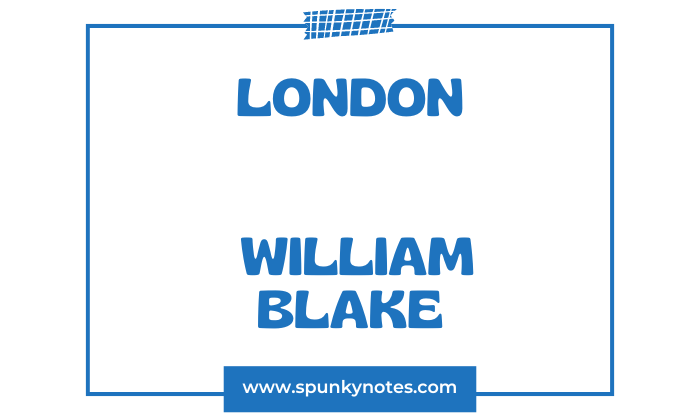

Updated on: October 13, 2025
Estimated Reading Time: 8 min

Estimated Reading Time: 8 min
Q. Critically evaluate the poem London by William Blake.
“London” is a poem by William Blake, published in his collection “Songs of Experience” in 1794. This poem provides a somber and critical view of London in the late 18th century.
It reflects Blake’s concerns with social injustice, moral decay, and the harsh realities of urban life during the Industrial Revolution.
London by William Blake Line-by-Line Explanation
Stanza 1
I wander thro’ each charter’d street,
Near where the charter’d Thames does flow.
And mark in every face I meet
Marks of weakness, marks of woe.
I wander thro’ each charter’d street,
The word “charter’d” (chartered) here is significant. In Blake’s time, the government or other authorities would officially regulate or control a chartered street. It suggests a lack of freedom and spontaneity.
His use of ‘wander’ implies a sense of aimlessness, contrasting with the structured, controlled environment.
Near where the charter’d Thames does flow.
The River Thames, a symbol of London, is also described as “charter’d,” extending the theme of control and regulation to nature itself. This could imply that human control constrains the river’s natural flow and freedom.
And mark in every face I meet
Blake is observing the people he encounters as he wanders. The word “mark” suggests he is paying close attention, noticing details others might overlook.
Marks of weakness, marks of woe.
This observation reveals that signs of suffering and sadness mark the faces of the people he sees.
“Weakness” and “woe” suggest both physical and emotional distress. It shows hardships and sorrows are conspicuous on the faces.
Stanza 2
In every cry of every Man,
*In every Infants cry of fear,
In every voice: in every ban,
The mind-forg’d manacles I hear
In every cry of every Man,
Blake begins this stanza by noting the universal distress among men in London. The repetition of “every” emphasizes the all-encompassing nature of this suffering. It is not limited to a specific group or area; it is a general condition affecting all.
In every Infants cry of fear,
The mention of infants crying in fear further intensifies the grim imagery. Infants represent innocence and vulnerability. Their fear suggests a society where even the most innocent are not free from the prevailing conditions of distress.
In every voice: in every ban,
This line likely refers to the laws, proclamations, and societal norms (the “bans”) that are in place. These restrictions contribute to people’s suffering and unhappiness.
“In every voice” could suggest that the complaints or protests of the people are ubiquitous.
The mind-forg’d manacles I hear
“Manacles” are restraints or handcuffs that bind a prisoner’s wrists. Describing them as “mind-forg’d” suggests that these restraints are not physical but mental.
Blake refers to the psychological chains that oppress people – the internalized beliefs and fears imposed by societal norms, institutions, and authority figures.
This line implies that the people of London are not only physically constrained by their circumstances (poverty, laws, social structures) but are also mentally imprisoned by their acceptance of these conditions as unchangeable.
Stanza 3
How the Chimney-sweepers cry
Every blackning Church appalls,
And the hapless Soldiers sigh
Runs in blood down Palace walls
How the Chimney-sweepers cry
Chimney sweepers in Blake’s time were often young children forced into hazardous and dirty jobs. Their cry symbolizes the exploitation and suffering of the most vulnerable members of society.
Blake emphasizes the social injustice where children, who should receive care and protection, endure harsh labor instead.
Every blackening Church appalls
The use of blackening the Church is highly symbolic. It could refer to the soot from chimneys darkening the buildings. This symbolizes the Church’s moral corruption and failure to protect the innocent, like the chimney sweepers.
Blake was often critical of the Church, seeing it as a hypocritical and oppressive institution.
The word “appalls” suggests that the Church reacts to the sweepers with hypocritical disdain or a failure to acknowledge them. The poet is horrified by the Church’s complicity in societal injustices.
And the hapless Soldiers sigh
The depiction of soldiers as “hapless” portrays them as unfortunate and deserving of pity. This reflects the plight of soldiers who, despite serving the nation, often lived in poverty and were treated as unimportant.
It underscores the theme of exploitation and neglect by those in power.
Runs in blood down Palace walls
This gruesome image suggests how the ruling class, symbolized by the “Palace,” depends on blood to sustain itself, or how ordinary people, including soldiers, sacrifice and suffer.
The line also criticizes the government’s active role in fueling war and conflict, thereby leading to needless bloodshed.
Stanza 4
But most thro’ midnight streets I hear
How the youthful Harlots curse
Blasts the new-born Infants tear
And blights with plagues the Marriage hearse
But most thro’ midnight streets I hear
This line sets the scene of wandering through London’s streets at night. “Most” indicates that what follows represents the speaker’s most notable observations.
How the youthful Harlots curse
The reference to “youthful Harlots” (sex workers) highlights the desperation and degradation faced by young women.
The term “curse” might refer to both the actual expressions of anger and anguish by these women and to the metaphorical ‘curse’ of being trapped in a life of exploitation.
This line underscores the moral decay and desperation that pervades the city.
Blasts the new-born Infants tear
It is particularly distressing, suggesting that the children of these women are born into suffering, their very entrance into the world marked by tears.
“Blasts” implies a destructive force, indicating that the city’s corrupt and harsh environment damages the most innocent and vulnerable from the very beginning of their lives.
And blights with plagues the Marriage hearse
The oxymoron “Marriage hearse” juxtaposes the traditional symbol of new beginnings and union (marriage) with death (hearse). This could represent the death of moral and social values in society.
Using “blights” and “plagues” suggests a widespread and destructive impact on these institutions. It could also critique the institution of marriage, which, in Blake’s view, might be corrupted or degraded in such a society.
How the youthful Harlots curse
By mentioning “youthful Harlots,” Blake draws attention to the young women forced into prostitution.
The term “youthful” is significant, as it underscores the innocence and vulnerability of these women, who are likely driven to prostitution by dire economic circumstances.
The fact that they are young highlights the societal failure to protect and nurture its young people.
curse
This word can be interpreted in multiple ways. Firstly, it could mean that these young sex workers are swearing or expressing their anguish and frustration verbally.
Alternatively, “curse” could be understood metaphorically, suggesting that their very existence in such a state is a curse—both on themselves and on the society that allows such degradation.
It could also imply that their situation ‘curses’ them with a life of misery and societal judgment.
In this line, Blake is not just commenting on the plight of harlots in London but also critiquing the societal conditions that lead to such a profession, especially for the young and vulnerable.
Like much of the poem, this line reflects Blake’s deep concern with social injustice and his empathy for those who suffer under oppressive systems.
Blasts the new-born Infants tear
Blasts
In the poem’s context, it suggests a force ruining or severely affecting something delicate and vulnerable.
The new-born Infants tear
This part of the line focuses on the tears of a newborn infant, a symbol of innocence and purity. Newborns represent the beginning of life, and their tears should ideally be due to basic needs rather than suffering.
However, in this context, these tears are likely indicative of pain, suffering, or the general distress present in the environment into which they are born.
In combination, “Blasts the Newborn Infants Tear” suggests that Blake critiques society’s harsh realities, which are so pervasive and destructive that they even affect its most innocent and vulnerable members.
Instead of being a natural and benign part of early life, their tears are portrayed as caused by the metaphorical ‘blast’ of social injustice and misery.
Blake’s use of such imagery is part of his critique of his time’s social, political, and economic conditions.
And blights with plagues the Marriage hearse
“Blights” refers to a damaging or destructive influence, while “plagues” suggests widespread affliction or disease. These words convey a sense of something being devastated or corrupted by pervasive, harmful forces.
The Marriage hearse
This phrase is a powerful and paradoxical juxtaposition. “Marriage” typically symbolizes love, union, and the beginning of a new life. In contrast, a “hearse” is associated with death and the end of life.


